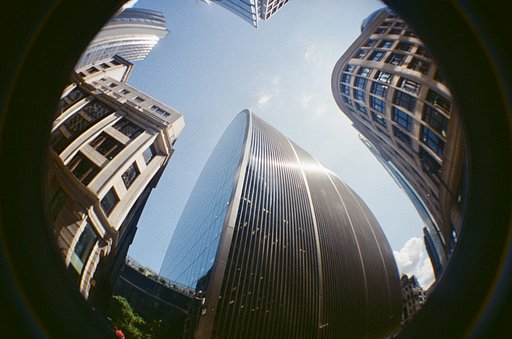Analogue Advocate Tony Kemplen Takes on the Utimate 110 Challenge
12 Share TweetAvid film photographer and writer Tony Kemplen has been shooting a different analogue camera every week for 10 years and he recently dedicated a full month to shooting just with 110 cameras. We decided he would be the perfect candidate for testing out the Diana Baby 110 and a range of Lomography 110 films and, in this interview, he shared his vast knowledge of this pocket film format with our community.
Hello Tony, welcome to the Lomography Magazine, please can you tell us a bit about yourself?
I live in Sheffield and have been fascinated by cameras and photography for most of my life. As I'm now in my early 60s I've had plenty of time to try lots of cameras and techniques. I'm also a bit of a collector in general, and although I don't have any particular collecting strategy, I've amassed a lot of cameras over time, mainly from jumble sales, car boot sales and charity shops. A few years ago I decided it was time to take my cameras off the shelves and start using them. In January 2010 I started using a different film camera each week, aiming to get through 52 in the year. Things got out of hand and my 52 cameras in 52 weeks project ended up lasting a decade, involving 522 different cameras and never missing a week. Since 2011 I've been writing a monthly column about my exploits in Amateur Photographer magazine. I've relaxed the pace now, but I still take a lot of photos on film. I'm also a fan of the Lomography cameras and own and use most of them, some on a regular basis.
You recently set yourself the challenge of shooting a different 110 camera each day for a month. How did you get on and what did you discover?
My April 110 challenge was part of a follow on from my 522 cameras project. This year I'm using a different film format each month, starting with the smallest in January and working my way up through the sizes. April's format was 110, and as I have a lot of 110 cameras, and was missing the pace of the weekly project, I decided to up my game and use a different camera each day.
I'd shoot two or three photos with one camera and then transfer the cartridge to another camera the next day. I got through 5 films altogether and managed to get at least one image out of each one, including the Lomography Fisheye Baby, in which I used the Orca black and white film.
What's the fascination with 110 film format?
Back in 1981 I was planning a trip to India and wanted to travel light. The Pentax Auto 110 had recently been launched, and this little automatic SLR with its interchangeable lenses seemed like the ideal camera to take with me. It stretched my student budget but has served me well, and I still use it 40 years later. It's the sheer size, or rather lack of it, that attracts me to the format, there are even cameras that are smaller than the film cartridge itself, they slip easily into the pocket and were literally sold as keyrings. The downside of course is that the negatives are only a quarter the size of 35mm, so technical quality is never going to be great, but their fun nature more than makes up for that.
We sent you the Diana Mini 110 and a selection of films. How did you get on with these, any film favourites?
Starting with the camera, this came as a nostalgic blast from the past. My grandmother gave me one of the Original Dianas more than 50 years ago, so receiving one of its descendants in the post felt like coming full circle! The Diana Mini 110 is a cute little camera, it's actually smaller than a 110 cartridge, and to use it you have to swap the standard back for a larger one that incorporates the film winder. With its plastic lenses and tiny negatives, this camera is more suited to creative photography than to something that demands clear crisp images. Fortunately, the facility to do multiple exposures and long (B) exposures, not normally found on a 110 camera, gives plenty of scope for experimenting. The square format also appeals to me, so this was an added bonus with the Diana, as all other 110 cameras produce rectangular images. I used the Lomochrome Metropolis and Lomography Tiger in the Diana. In some of the Metropolis shots, the shutter was inadvertently left on the “B” setting, but the resulting heavily over-exposed photos have a certain grungy lo-fi appeal to them.
Next, I tried out the Lomography Lobster RS200. I've used the redscale technique a lot and I usually “roll my own” 35mm cassettes, but DIY's not an option with 110, so it was good to have a chance to try it out in this format. One of the things that I like about the Lomography films is the attention to detail, I like the edge markings and borders, so I scanned the negatives myself to include them, as standard lab scans will usually crop to the image area only. For those who don't know, redscale is a technique whereby the film is deliberately shot from the wrong side, so in the case of color negative film there's is an orangey-red color cast caused by the colored film base, it's a bit like shooting through an orange filter. To my mind, the technique works best with cityscapes rather than landscapes, and most of my redscale stuff is architectural. These were taken with the Pentax Auto 110, which can handle a range of lighting conditions.
Do you have any tips for someone wanting to get into 110 film?
Well of course the first thing you need is a camera. If you or an older family member hasn't got one tucked away somewhere, you'll have no trouble finding one in a charity shop or car boot sale. Most are very simple, with little to go wrong, but you need to be more careful when it comes to those with electronic exposure systems. Then of course there are the Lomography 110 cameras, which unlike the vast majority of more traditional models, offer the possibility of multiple exposures and long exposures to get your creative juices flowing. The simple cameras are fine for bright daylight, but if you want the flexibility to shoot in a wider range of lighting conditions I suggest looking out for something more sophisticated. The Pentax Auto 110 was made in large numbers and is easy to come by, another nice, neat but well-specified model is the Rollei A110. Thanks to Lomography there's now a wider range of 110 film types available than ever there was. A number of labs offer processing and scanning of negatives, with the option of getting prints if you want them.
To see more of Tony's work visit his Flickr and Instagram page. Share your own 110 photos on social media using the hashtag #lomopocket110.
2021-08-11 #gear #news #110-film #110-cameras #lomopocket110

































No Comments